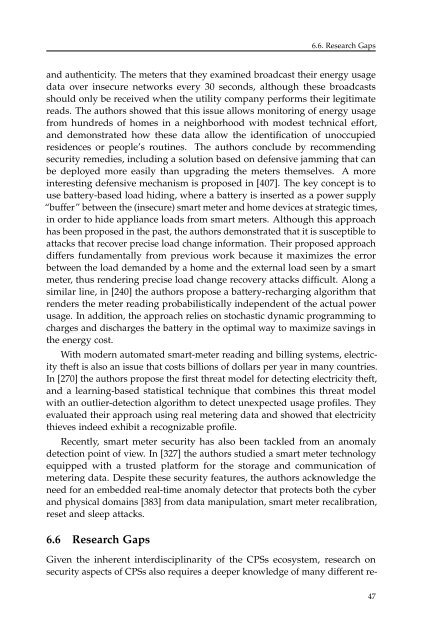syssec_red_book
syssec_red_book
syssec_red_book
You also want an ePaper? Increase the reach of your titles
YUMPU automatically turns print PDFs into web optimized ePapers that Google loves.
6.6. Research Gapsand authenticity. The meters that they examined broadcast their energy usagedata over insecure networks every 30 seconds, although these broadcastsshould only be received when the utility company performs their legitimatereads. The authors showed that this issue allows monitoring of energy usagefrom hund<strong>red</strong>s of homes in a neighborhood with modest technical effort,and demonstrated how these data allow the identification of unoccupiedresidences or people’s routines. The authors conclude by recommendingsecurity remedies, including a solution based on defensive jamming that canbe deployed more easily than upgrading the meters themselves. A moreinteresting defensive mechanism is proposed in [407]. The key concept is touse battery-based load hiding, where a battery is inserted as a power supply“buffer” between the (insecure) smart meter and home devices at strategic times,in order to hide appliance loads from smart meters. Although this approachhas been proposed in the past, the authors demonstrated that it is susceptible toattacks that recover precise load change information. Their proposed approachdiffers fundamentally from previous work because it maximizes the errorbetween the load demanded by a home and the external load seen by a smartmeter, thus rendering precise load change recovery attacks difficult. Along asimilar line, in [240] the authors propose a battery-recharging algorithm thatrenders the meter reading probabilistically independent of the actual powerusage. In addition, the approach relies on stochastic dynamic programming tocharges and discharges the battery in the optimal way to maximize savings inthe energy cost.With modern automated smart-meter reading and billing systems, electricitytheft is also an issue that costs billions of dollars per year in many countries.In [270] the authors propose the first threat model for detecting electricity theft,and a learning-based statistical technique that combines this threat modelwith an outlier-detection algorithm to detect unexpected usage profiles. Theyevaluated their approach using real metering data and showed that electricitythieves indeed exhibit a recognizable profile.Recently, smart meter security has also been tackled from an anomalydetection point of view. In [327] the authors studied a smart meter technologyequipped with a trusted platform for the storage and communication ofmetering data. Despite these security features, the authors acknowledge theneed for an embedded real-time anomaly detector that protects both the cyberand physical domains [383] from data manipulation, smart meter recalibration,reset and sleep attacks.6.6 Research GapsGiven the inherent interdisciplinarity of the CPSs ecosystem, research onsecurity aspects of CPSs also requires a deeper knowledge of many different re-47


